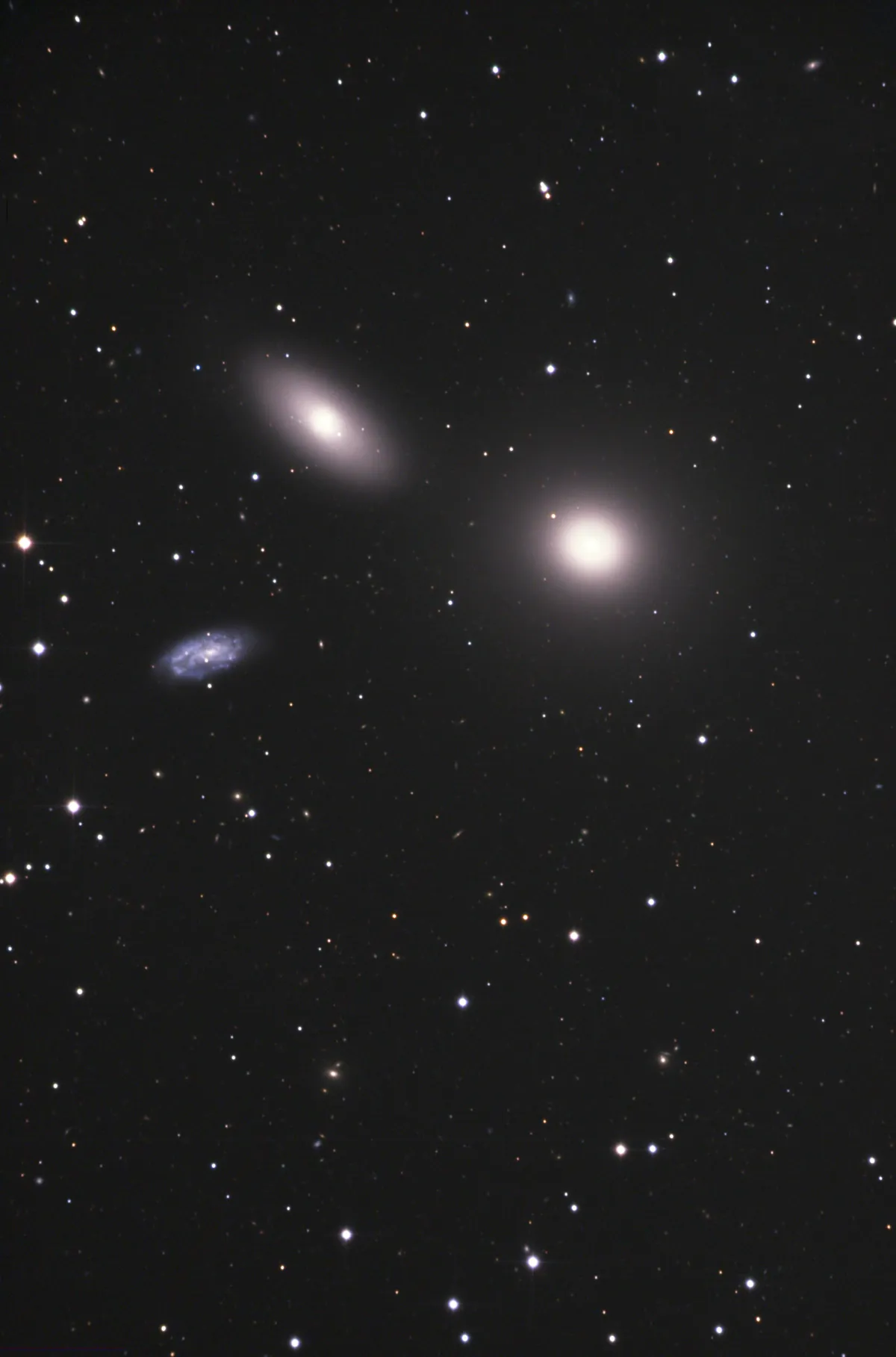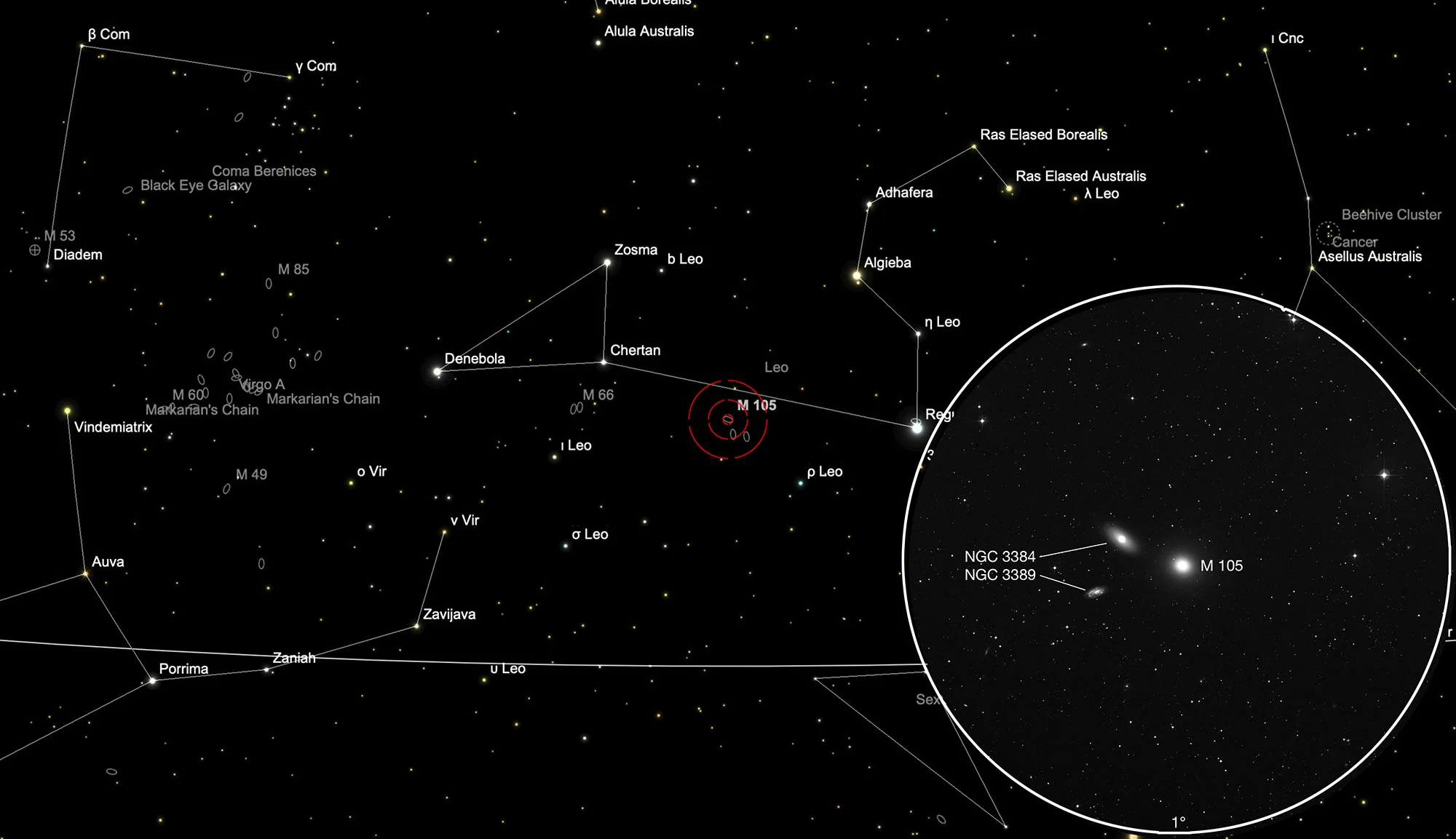Galaxies Messier 105, NGC 3384 & NGC 3389

History
Pierre Méchain discovered the galaxy M 105 on 24 March 1781, just four or five days later thanM 95 and M 96, which are only about 1° away. For unknown reasons, this discovery did not make it into the original Messier catalog, which appeared in the 1784 «Connoissance des Temps». Independently of this, William Herschel came across this galaxy on 11 March 1784, which Dreyer later included in the «New General Catalogue» as NGC 3379. Since Méchain's discovery was in the same period as the discovery of the last objects in the Messier catalog, it was added in 1947 by Helen Sawyer Hogg as M 105 together with M 106 and M 107. [217]
Physical Properties
M 105 is an elliptical galaxy and a member of the approximately 40 million light-years distant Leo I group of galaxies, which contains M 95, M 96 and other weaker galaxies. Like most elliptical galaxies, M 105 appears to be fairly structureless and inactive, but observations with the Hubble Space Telescope have shown that new stars are still emerging in the galaxy believed to be dead. Measurements of the star movements in the centre revealed a supermassive black hole of about 200 million solar masses. Measurements of the redshift over the past 20 years show a heliocentric velocity of 874 km/s to 911 km/s and a distance of 8 Mpc to 17 Mpc (26 to 55 million light years). [145, 215]
The galaxy NGC 3384 was discovered by William Herschel on 11 March 1784. At NED one finds a morphological type according to de Vaucouleurs of SB0^-(s), which is a lenticular galaxy in transition to a bar spiral. According to Zimbab, measured heliocentric speeds are in the range from 563 km/s to 735 km/s and distances from 8 Mpc to 11 Mpc (26 to 35 million light years). The galaxy is therefore closer than M 105. [145, 194, 196]
At a distance of 19 Mpc to 21 Mpc (62 to 69 million light years), the spiral galaxy NGC 3389 is slightly further away than the other two. It is of the morphological type SA(s)c and was also discovered by William Herschel on 11 March 1784. [145, 194, 196]
| Name | RA | Dec | Type | bMag | vMag | B-V | SB | Dim | PA | z | D(z) | MD | Dreyer Description | Identification, Remarks |
|---|---|---|---|---|---|---|---|---|---|---|---|---|---|---|
| NGC 3379 | 10 47 49.5 | +12 34 52 | Gx (E1) | 10.2 | 9.3 | 0.9 | 12.8 | 5.3 × 4.8 | 71 | 0.003039 | 12.84 | 10.390 | vB, cL, R, psbM, r | WH I 17; h 757; GC 2203; M 105; UGC 5902; MCG 2-28-11; CGCG 66-18 |
| NGC 3384 | 10 48 16.7 | +12 37 43 | Gx (E/SB0) | 10.9 | 9.9 | 1.0 | 12.7 | 5.4 × 2.7 | 53 | 0.002348 | 9.92 | 11.590 | vB, L, R, psmbM, 2nd of 3 | WH I 18; h 758; GC 2207; NGC 3371; UGC 5911; MCG 2-28-12; CGCG 66-21; PRC C-34 |
| NGC 3389 | 10 48 28.0 | +12 31 59 | Gx (Sc) | 12.4 | 11.9 | 0.5 | 13.2 | 2.9 × 1.3 | 112 | 0.004364 | 18.43 | 21.290 | F, L, E pf, vglbM, 3rd of 3 | WH II 41; h 761; GC 2211; NGC 3373; UGC 5914; MCG 2-28-13; CGCG 66-22 |
Finder Chart
The three galaxies are located in the constellation Leo, roughly in the middle between the stars Chertan (θ Leonis) and Regulus (α Leonis), only about 1° northeast of M 95/96. The best observation time is in the months of November to August.
Visual Observation
400 mm Aperture: Even at higher magnification (9 mm Nagler, 200x), all three galaxies appear only as featureless ovals, of which M 105 and NGC 3384 show a bright core. — 400 mm f/4.5 Taurus Dobsonian, Hasliberg, SQM 21.2, 3. 2. 2024, Bernd Nies
